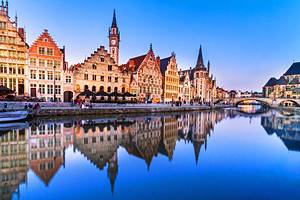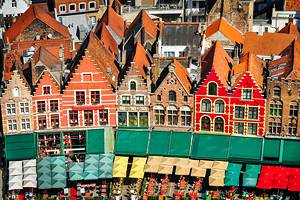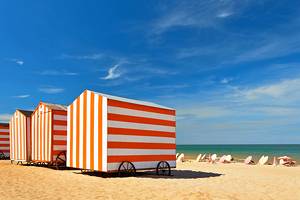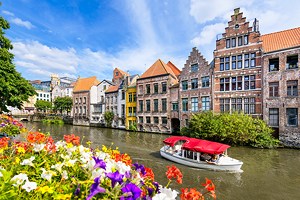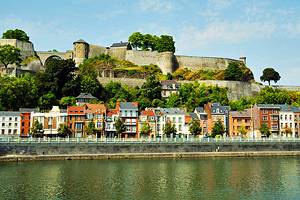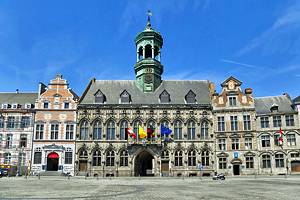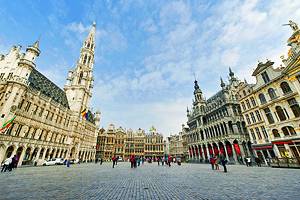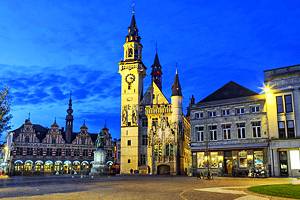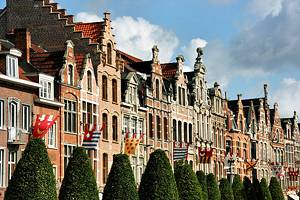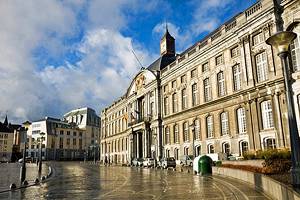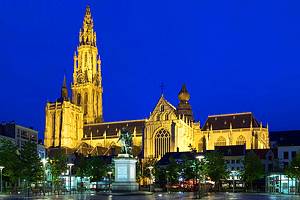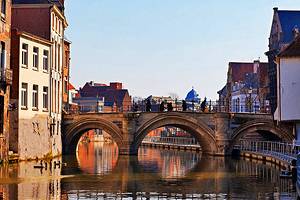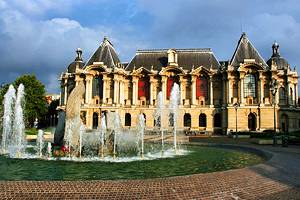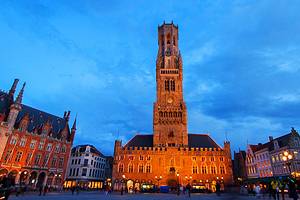Places to Visit in Belgium
Tourists will find a surprising variety of things to do in Belgium, from beautiful natural settings to historic landmarks and cultural attractions.
Couples looking for romantic places to visit will enjoy the medieval ambience of old cities like Bruges and Ghent, while those traveling with kids will find plenty of family-friendly activities in the capital city of Brussels and the historic port town of Antwerp.
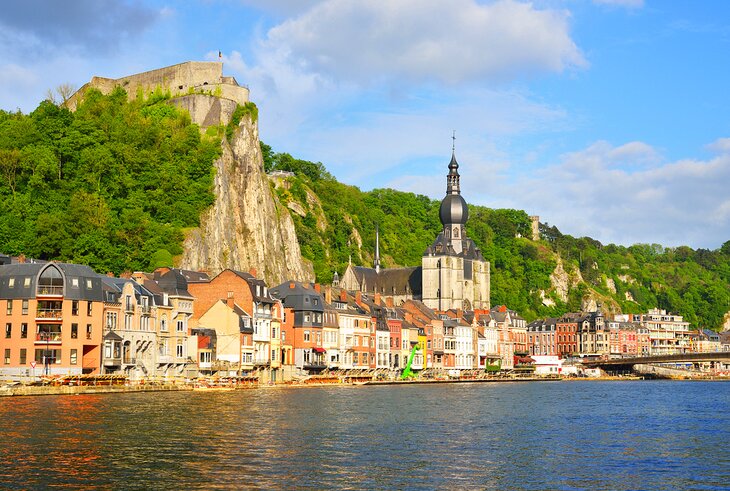
Military history buffs have plenty to look forward to as well, from the remote battlefields of Flanders to numerous excellent museums dedicated to Belgium's role in the two World Wars.
Find all this and so much more with our list of the best places to visit in Belgium.
- Medieval Bruges
- Upper Meuse Valley
- Brussels: The Heart of Europe
- Memorials and Battlefields of Flanders
- Antwerp: The Cultural Capital of Flanders
- Canals, Castles, and Cathedrals of Ghent
- Mons (Bergen)
- Leuven
- The Beaches of Belgium
- Dinant
- Belgium's Cathedrals and Churches
- Map of Places to Visit in Belgium
Medieval Bruges

Bruges is one of the most visited cities in Belgium due to its medieval architecture and thoroughly romantic ambience. Bruges' canals are one of its most charming features, and no visit to the town is complete without a scenic canal boat tour.
From the water, you will be able to enjoy a different perspective of the city; land-lovers can likewise stroll along the canals to watch the boats go by, and the local tourist office has free walking tours available. Of particular note are the mansions along the Dijver Canal, some of which now house museums.
The historic center's two main squares, Burg Square (also known as simply "the Burg") and the Markt Square, which sit adjacent to each other in the middle of the city. Markt Square is surrounded by several impressive buildings, but the Halle and its 83-meter belfry are by far the most imposing structure. The belfry, which was started in 1282 and completed in 1482, is home to 47 bells and has a viewing area for tourists who are brave enough to climb the 366 steps to the top.

Aficionados of ecclesiastic architecture will want to visit the Basilica of the Holy Blood on Burg Square, which has a combination of Romanesque and late Gothic styles. The Burg is also home to the historic Town Hall (Stadhuis), which was completed in 1420, and the tourist office, which is housed in the Liberty of Bruges, the former Law Courts.
Those staying in Bruges will find many fascinating towns and tourist sites within a short drive. For a walk or pedal bike ride, the trails along the Schipdonkkanaal are particularly nice, and canal boat tours are also available here. The small down of Damme is home to several historic buildings and a traditional Flemish atmosphere.
Located near the coast, Bruges is also convenient to the seaside and beach communities of Knokke and Ostend, as well as the popular cruise ship port at Zeebrugge. Knokke is best known for its upscale resort community of Knokke-Heist, but is also a hub for art lovers, with an astounding 85 galleries and numerous public art installations. Along with the beaches of Ostend, tourists can visit several good museums including the De Plate Museum, with local history, and the Museum of Fine Art.
Read More:
Upper Meuse Valley
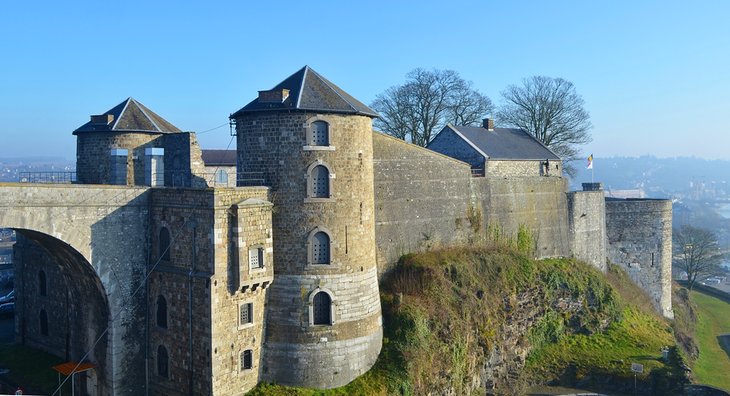
The Meuse River splits the country north and south, E42 from Liege to Namur, and from there to Dinant. The valley is known for its idyllic small towns, dramatic limestone cliffs, and lush forests that are ribboned with trails.
Namur (also called Namen) sits in the heart of the valley and is home to several historic landmarks, as well as a large university. The Namur Citadel sits on an outcropping above the town and is a fun place to explore, as well as an excellent spot for panoramic views of the valley.
In town, the best sightseeing areas are along the Rue de Fer and in the central Old Town, where you will find several good museums, as well as shops and cafés. You can also see historic churches, including the 18th-century Cathedral of Saint Aubain and the Church of Notre-Dame and its ecclesiastical Treasury, which houses several priceless religious items.
About 28 kilometers to the south sits another of Belgium's loveliest cities, Dinant, which is also home to a stately citadel. West of Namur, the village of Floreffe is home to a stunning 12th-century abbey, formerly the Premonstratensian Abbey, which now houses a seminary. The abbey church still contains some of its original features and is a lovely place to visit.
The next town over is Fosses-la-Ville, also home to a 12th-century monastery. Unfortunately, very little of the original is intact, however visitors can still admire the crypt, choir, and tower.
Northeast of Namur near Franc-Waret is Franc-Waret Castle, a beautiful 17th-century fortified residence. Visitors can tour the castle and grounds; the interior has a variety of original furnishings, artwork, and rare items, while the gardens are carefully tended to appear as they did during the castle's heyday.
- Read More: Tourist Attractions in Namur
Brussels: The Heart of Europe

The capital city of Brussels is a must-see destination for any tourist visiting Belgium, home to not only the seat of the Belgian Royal Family but also the central offices of the European Union.
Thanks to the diverse mix of the city's residents, Brussels is known for its variety of restaurants and cafés that represent many gastronomic heritages. In addition to a thriving and lively city center, the Old Town is home to many historic landmarks and fine examples of Baroque and Gothic architecture.
In the heart of the Old Town, tourists will find the main square, the Grand Place (Grote Markt). This is home to the imposing Brussels Town Hall (Hôtel de ville de Bruxelles), as well as the city's numerous historic Guild Houses (Gildehuizeb).
Nearby, on the Rue de l'Etuve, is the famous Mannekin Pis statue. Also nearby is the stunning Saint-Michel Cathedral, a Gothic church that was begun in 1225 and features twin towers and spectacular stained-glass windows.

Overlooking the old city center is the royal family's official residence, the Palais Royale. On the palace grounds is the excavated Coudenberg Palace Archaeological Site, a fascinating dig site of the original palace's foundations and long-buried streets that is open for tourists to explore.
Adjacent to the palace is The Mont des Arts, home to several museums, including the Belgian Royal Museum of Fine Arts, which features an ancient art wing and a modern art wing.
More national museums can be found on the grounds of the expansive Parc du Cinquantenaire, which is located near the European Union Headquarters. Here, you can find the Belgian Army Museum and Museum of Military History, as well as the Royal Art and History Museum.
- Read More: Day Trips from Brussels
Memorials and Battlefields of Flanders

Tourists who want to visit some of the most important battlefields, memorials, and conflict-related landmarks will want to start their pilgrimage in Ypres, the sight of some of the most brutal trench warfare during WWI. To get a good overview of the area's involvement and history, as well as see artifacts from the conflicts, visit the In Flanders Fields Museum, located in Ypres's historic Lakenhalle on its main square, the Grote Markt.
After visiting Rijselpoort, the fortified gate where British soldiers set up the command center, tourists typically begin the battlefield tour from Menin Gate. It was from Menin Gate that troops marched into battle, and today it also serves as a memorial to the British soldiers who never returned home after the battles — 54,896 names are inscribed in its surface, and Last Post has been sounded at this spot every night at 8pm since 1928.
The area around Ypres is home to several war cemeteries, including Tyne Cot Cemetery, the largest of the British cemeteries in Flanders. Located about 12 kilometers from Ypres, it is the final resting place for approximately 12,000 soldiers and a memorial to over 35,000 more.
Nearby, tourists will find a smaller memorial dedicated to Canadian soldiers who died in 1915 in the first German gas attack. In the nearby town of Langemark, there is a cemetery for German soldiers with nearly 45,000 graves of the shockingly young men who died here in 1914.
There are additional sites clustered in and around the village of Kemmel, a region that saw heavy fighting. Tourists will find several war cemeteries in the Kemmelberg area, as well as a water-filled crater that was created by the British blasting local mines. Today it is known as Lone Tree Crater, and the body of water is the Pool of Peace.
- Read More: Tourist Attractions in Ypres
Antwerp: The Cultural Capital of Flanders

The port city of Antwerp has many cultural and historic sites to visit; it's known both for its industry and artistic influences. The majority of the city's most significant buildings are on and around the Grand Place (Grote Markt) in the center of the old town. In this area, tourists will find the 16th-century Town Hall (Stadhuis), the Butcher's Hall (Vleeshuis), and Rubens' House (Rubenshuis).
Those arriving by train into the impressive Central Station (Middenstatie) will find a treat waiting for them next door at Chocolate Nation, the world's largest Belgian chocolate museum. This is a big hit with families, conveniently adjacent to the Antwerp Zoo. The zoo, which was founded in 1843, is known not only for its population of over 950 species but also for its beautiful Art Deco architecture and stylized animal habitats.
Antwerp is also known for its excellent museums, which explore a variety of topics. History lovers will enjoy the Red Star Line Museum, which focuses on emigration during the late 19th and early 20th centuries, as well as the Museum aan de Stroom (MAS), which includes exhibits about local history, as well as artifacts from around the world. The Museum Mayer van den Bergh is an excellent fine arts museum, as is the Royal Museum of Fine Arts.
- Read More: Day Trips from Antwerp
Canals, Castles, and Cathedrals of Ghent

Tourists who want to enjoy the romantic atmosphere of a medieval town without the crowds of Bruges will want to visit Ghent, a rival in architectural and historical significance.
The majority of Ghent's historic guild houses can be found along the Graseli Canal and the Korenlei Canal, including the Koornstapelhuis, which dates from the early 13th century; the Gildehuis der Metselaars (House of the Masons) built in 1527; and the Tolhuisje (Customs House), which was built in 1682. Those lucky enough to visit in the evening should make time for a canal boat cruise to appreciate the sight of these lovely buildings lit from below.
In the heart of Ghent's Old Town, the impressive Gravensteen is moated by the diverted waters of the Lieve River. This massive medieval fortress was constructed in the late 12th century and has all the grandeur and classic elements of a fairy-tale castle. Today, it is home to a museum that features artifacts from the building's varied uses, from a royal residence to a textile factory.
If you love exploring castles, you can also visit the beautiful Laarne Castle, which is located just 11 kilometers from Ghent. This pentagonal fortress was built in the 11th century and also houses historic exhibits.
- Read More: Tourist Attractions in Ghent
Mons (Bergen)

Located near the French border, Mons sits between the Trouille and Haine rivers along the route between Paris and Brussels. The Grand-Place de Mons sits in the city center and is home to several historic buildings, as well as plenty of shops, cafés, and restaurants along its picturesque cobblestone streets.
The City Hall (Hôtel de Ville de Mons) stands at the head of the city's main square, and the remaining four sides of the large courtyard are flanked by buildings dating to the 15th through 18th centuries.
Just a couple of blocks away from the main square at the top of a hill, you will find the Belfry of Mons, also known as El Caitau. This UNESCO-listed bell tower was constructed in the 17th century in the Baroque style and stands at 87 meters tall with a carillon of 47 bells. Here, you can climb the stairs to the observation platform at the top for panoramic views of the city. At the foot of the hill sits the 15th-century Brabant Gothic Collegiate Church of Sainte-Waudru.
Mons is also home to several good museums, and history buffs will want to prioritize a visit to the Mons Memorial Museum, formerly called the War Museum. The museum has over 5,000 artifacts relating to the country's involvement and occupation during both World Wars and also includes interactive exhibits.
Art lovers will appreciate the paintings at the Musée des Beaux Arts (Fine Arts Museum), as well as the unique collections at the Decorative Arts Museum Francois Duesberg.
- Read More: Tourist Attractions in Mons (Bergen)
Leuven

Located about 30 kilometers east of Brussels, Leuven sits on the river Dijle and is home to one of the country's oldest and most famous universities. You can see many fine examples of Gothic and other architectural styles on the university campus and throughout the city, starting with Leuven's City Hall that features 236 figures on its ornate façade.
Just next door across the Grote Markt sits St. Peter's Church (Sint-Pieterskerk), a fine cathedral built in the Brabant Gothic style that houses the Museum of Religious Art. The university's most historic buildings can also be found nearby along the Naamsestraat.
Outside the historic city center, Leuven has several lovely tourist attractions for nature-lovers. The Leuven Botanical Garden Kruidtuin, originally created in 1738 as the medicinal plant garden for the university's medical students, is now home to a variety of flora.
About four kilometers from the center of town, the borough of Kessel-Lo is home to a large nature park that is free to visitors, featuring swimming and paddleboating in the lakes, a petting zoo, and other activities.
- Read More: Tourist Attractions in Leuven
The Beaches of Belgium
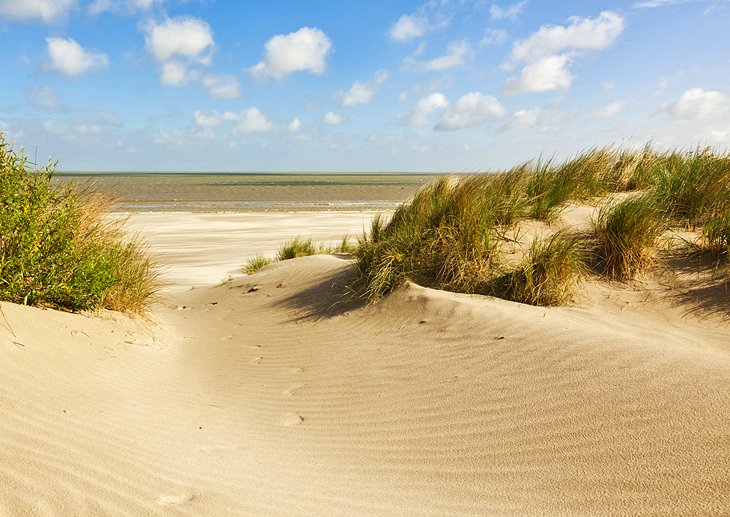
Although most people don't immediately think of beaches when planning a trip to Belgium, the west coast offers several excellent choices for those who want to soak up some sun and take a dip.
If you're staying in Bruges and Ghent, you can get to most beaches by car in 30- to 45 minutes at most, but day trips from Brussels and even Antwerp are still reasonable at around an hour-and-a-half by car, with additional options via train. Once you're on the coast, it's super-easy to hop from beach to beach on the Coastal Tram, which has 70 stops.
Knokke-Heist is one of the best known of Belgium's beach resort communities and is located near the Dutch border, only about 19 kilometers from Bruges. The town has four beaches along its 12-kilometer coastline, as well as numerous walking, hiking, and cycling trails that wander through the dunes. Visitors will find that Knokke is also home to an astounding number of art galleries, as well as two excellent museums about local and Belgian history.

The town of Ostend may be best known as the main ferry port between Belgium and Great Britain, but it is also home to seaside resorts and beaches, conveniently located only 29 kilometers from Bruges. There is a lovely promenade that runs along the beach, and a breakwater that offers good views of the small city.
Ostend is home to six distinct beach areas, including Sportstrand (Sports Beach), which is dedicated entirely to active fun-in-the-sun, with designated areas for volleyball, kite-flying, and surfing, among other beach sports.
If you want to admire the beautiful architecture of the Koninklijke Gaanderijen (Royal Galleries) while you enjoy the water, head to the western end of the two-kilometer Groot Strand.
Dinant

The town of Dinant is located 28 kilometers south of Namur and is a popular place to visit for tourists in the upper Meuse Valley.
The heart of this charming town sits in a narrow swath between the Meuse River and an imposing limestone cliff, atop which a citadel has perched since the 11th century. The Dinant Citadel can be reached via a 408-step stone stairway that was built in 1577, but nobody will judge you if you opt for the scenic cable car ride instead. Once here, you can explore the battlements, former barracks, kitchens, and dungeons, as well as enjoy stunning views of the valley below.
The 16th-century Collegiate Church of Notre-Dame is another of Dinant's major landmarks, featuring a 100-meter onion dome and a unique perch in the side of the cliffs below the citadel. Other top tourist destinations include the Grotte la Merveilleuse, a major limestone cave system that can be explored, and the Rocher Bayard, an impressive pillar of limestone.
The Meuse Bridge is an excellent spot for photography, and boating on the Meuse River is a popular activity in Dinant. The town is also known for being the birthplace of Adolphe Sax, the inventor of the first saxophone, and visitors will find multiple monuments honoring him throughout the town, as well as tour his former home, which is now a museum.
Belgium's Cathedrals and Churches
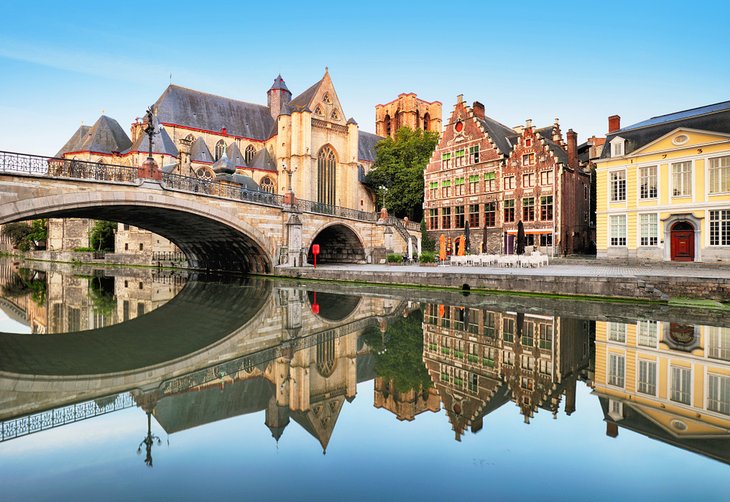
The city of Ghent is home to several of Belgium's most beautiful historic churches, the most lovely of which is the impressive Saint Michael's Church, constructed in the Gothic style of Belgian sandstone. Adjacent to this church is Sint-Michielsbrug (Saint Michael's Bridge), and together they are one of the most iconic landmarks in the city.
Another excellent example of Gothic architectural styles is Ghent's Cathedral of St. Bavo (Sint-Baafskathedraal), with a choir dating back to the 13th century and a tower constructed in the 15th century.
Among Antwerp's historic churches is the late Gothic St. Paul's Church (Sint-Pauluskerk), which is home to paintings by Van Dyck, Rubens, and Jordaens, and the country's largest Gothic cathedral, the Cathedral of Our Lady, which was begun in 1352.


